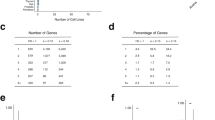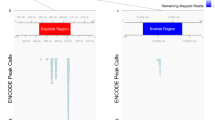Abstract
Because off-target effects hamper interpretation and validation of RNAi screen data, we developed a bioinformatics method, genome-wide enrichment of seed sequence matches (GESS), to identify candidate off-targeted transcripts in primary screening data. GESS analysis revealed a prominent off-targeted transcript in several screens, including MAD2 (MAD2L1) in a screen for genes required for the spindle assembly checkpoint. GESS analysis results can enhance the validation rate in RNAi screens.
This is a preview of subscription content, access via your institution
Access options
Subscribe to this journal
Receive 12 print issues and online access
$259.00 per year
only $21.58 per issue
Buy this article
- Purchase on Springer Link
- Instant access to full article PDF
Prices may be subject to local taxes which are calculated during checkout



Similar content being viewed by others
References
Jackson, A.L. & Linsley, P.S. Nat. Rev. Drug Discov. 9, 57–67 (2010).
Mohr, S., Bakal, C. & Perrimon, N. Annu. Rev. Biochem. 79, 37–64 (2010).
Sigoillot, F.D. & King, R.W. ACS Chem. Biol. 6, 47–60 (2011).
Jackson, A.L. et al. Nat. Biotechnol. 21, 635–637 (2003).
Tschuch, C. et al. BMC Mol. Biol. 9, 60 (2008).
Bartel, D.P. Cell 136, 215–233 (2009).
Lin, X. et al. Oncogene 26, 3972–3979 (2007).
Lin, X. et al. Nucleic Acids Res. 33, 4527–4535 (2005).
Schultz, N. et al. Silence 2, 3 (2011).
Musacchio, A. & Salmon, E.D. Nat. Rev. Mol. Cell Biol. 8, 379–393 (2007).
Tsui, M. et al. PLoS ONE 4, e7339 (2009).
Kapoor, T.M., Mayer, T.U., Coughlin, M.L. & Mitchison, T.J. J. Cell Biol. 150, 975–988 (2000).
Adamson, B., Smogorzewska, A., Sigoillot, F.D., King, R.W. & Elledge, S.J. Nat. Cell. Biol. advance online publication, 10.1038/ncb2426 (19 February 2012).
Sudbery, I., Enright, A.J., Fraser, A.G. & Dunham, I. BMC Genomics 11, 175 (2010).
Michel, L.S. et al. Nature 409, 355–359 (2001).
Benjamini, Y. & Hochberg, Y. J. Royal Stat. Soc. B 57, 289–300 (1995).
Bonferroni, C. Pubblicazioni del R Istituto Superiore di Scienze Economiche e Commerciali di Firenze 8, 3–62 (1936).
Holm, S. Scandinavian Journal of Statistics 6, 65–70 (1979).
Acknowledgements
We thank members of the Institute of Chemistry and Cell Biology and C. Shamu for providing siRNA sequences for hits from the Eg5-inhibitor RNAi screen as well as the use of facility equipment for our screening experiments, S. Natesan and P. August for helpful discussions in early stages of this work, S. Elledge for helpful discussions and for critical reading of the manuscript and J. Ware at the Harvard Catalyst Biostatistics consulting group for help in devising the statistical analysis workflow in the present manuscript. Funding for statistical analysis was supported in part by grant 1 UL1 RR025758-01, Harvard Clinical and Translational Science Center, from the US National Center for Research Resources; the content is solely the responsibility of the authors and does not necessarily represent the official views of the National Center for Research Resources or the US National Institutes of Health. This research was funded by a Sanofi-Aventis grant and US National Institutes of Health grant GM66492 to R.W.K.
Author information
Authors and Affiliations
Contributions
F.D.S., S.L. and R.W.K. conceived the study. F.D.S., S.L., E.C., B.Q. and B.A. performed the experiments. F.D.S. and J.F.H. wrote the GESS program code. F.D.S. and R.W.K. wrote the manuscript.
Corresponding author
Ethics declarations
Competing interests
The authors declare no competing financial interests.
Supplementary information
Supplementary Text and Figures
Supplementary Figures 1–12, Supplementary Tables 1–3, Supplementary Results 1–4 (PDF 1158 kb)
Supplementary Data 1
All siRNA sequences and associated phenotype data files analyzed in this report are provided as a compressed archive file. (ZIP 328 kb)
Supplementary Data 2
All GESS analysis result excel files are provided as a compressed archive file. (ZIP 9541 kb)
Supplementary Data 3
Transcript sequence databases for the human and mouse genomes. (ZIP 47153 kb)
Supplementary Software 1
GESS standalone package with manual, Windows 32-bit. (ZIP 181068 kb)
Supplementary Software 2
GESS standalone package with manual, Windows 64-bit. (ZIP 203935 kb)
Supplementary Software 3
GESS standalone package with manual, Linux 32-bit. (ZIP 403658 kb)
Supplementary Software 4
GESS standalone package with manual, Linux 64-bit. (ZIP 245937 kb)
Supplementary Software 5
GESS standalone package with manual, Mac. (ZIP 159083 kb)
Rights and permissions
About this article
Cite this article
Sigoillot, F., Lyman, S., Huckins, J. et al. A bioinformatics method identifies prominent off-targeted transcripts in RNAi screens. Nat Methods 9, 363–366 (2012). https://doi.org/10.1038/nmeth.1898
Received:
Accepted:
Published:
Issue Date:
DOI: https://doi.org/10.1038/nmeth.1898
This article is cited by
-
Genome-scale pan-cancer interrogation of lncRNA dependencies using CasRx
Nature Methods (2024)
-
CRISPR–Cas system to discover host-virus interactions in Flaviviridae
Virology Journal (2023)
-
Preventing autosomal-dominant hearing loss in Bth mice with CRISPR/CasRx-based RNA editing
Signal Transduction and Targeted Therapy (2022)
-
Cas13d knockdown of lung protease Ctsl prevents and treats SARS-CoV-2 infection
Nature Chemical Biology (2022)
-
Optimized RNA-targeting CRISPR/Cas13d technology outperforms shRNA in identifying functional circRNAs
Genome Biology (2021)



